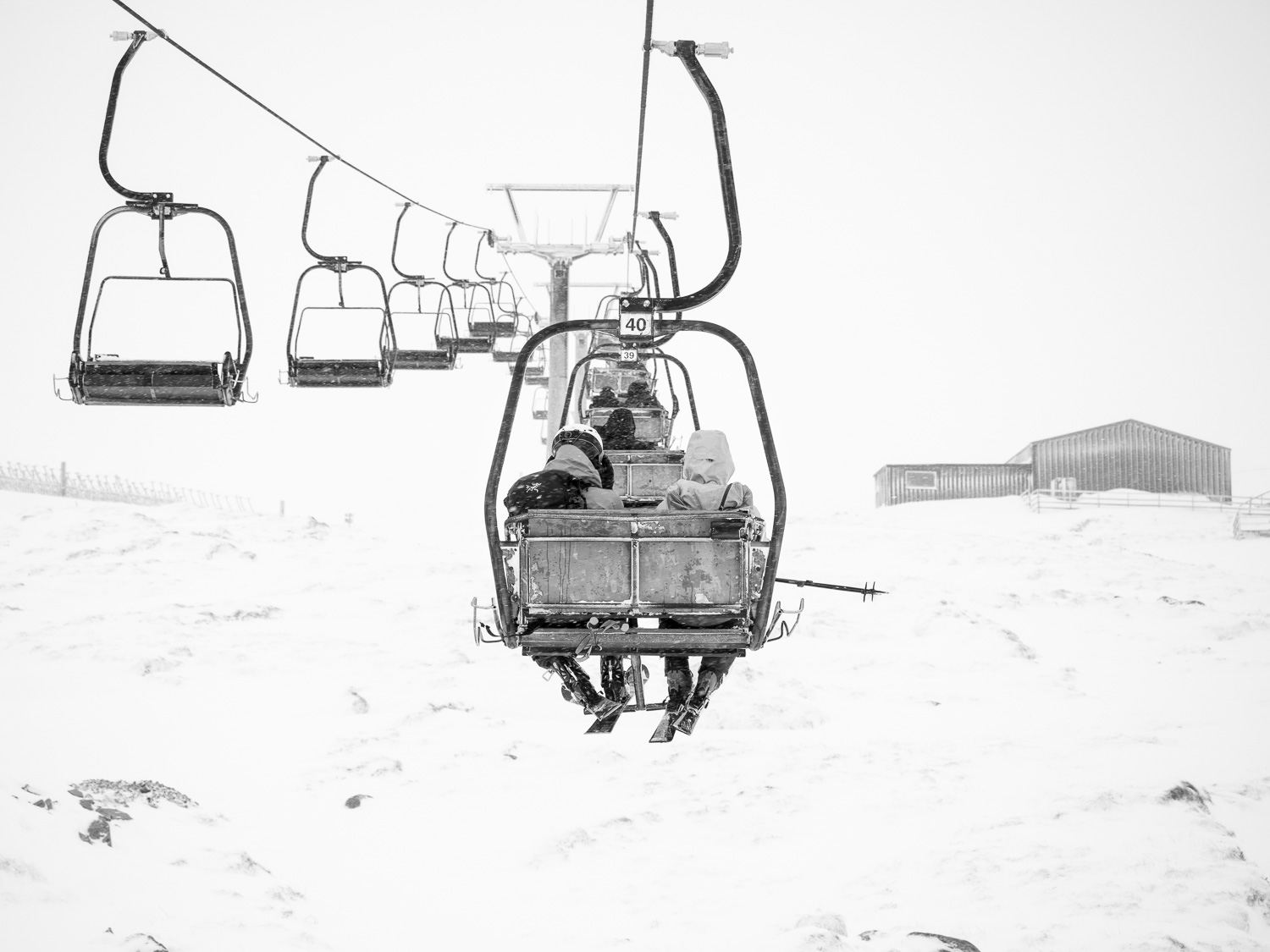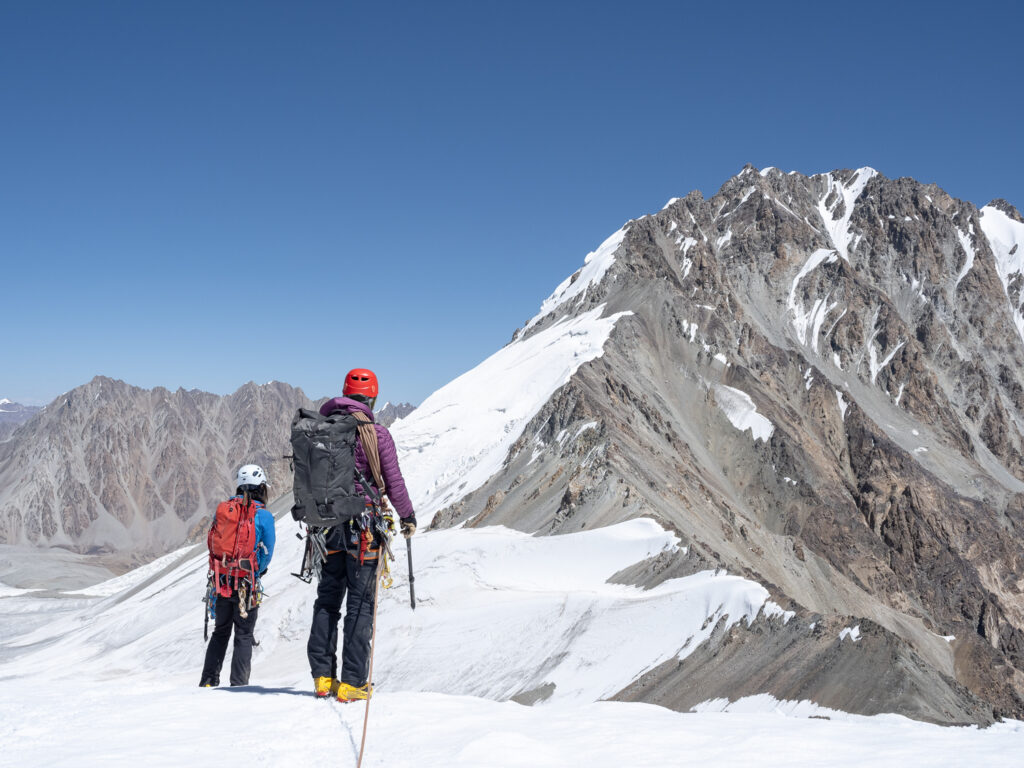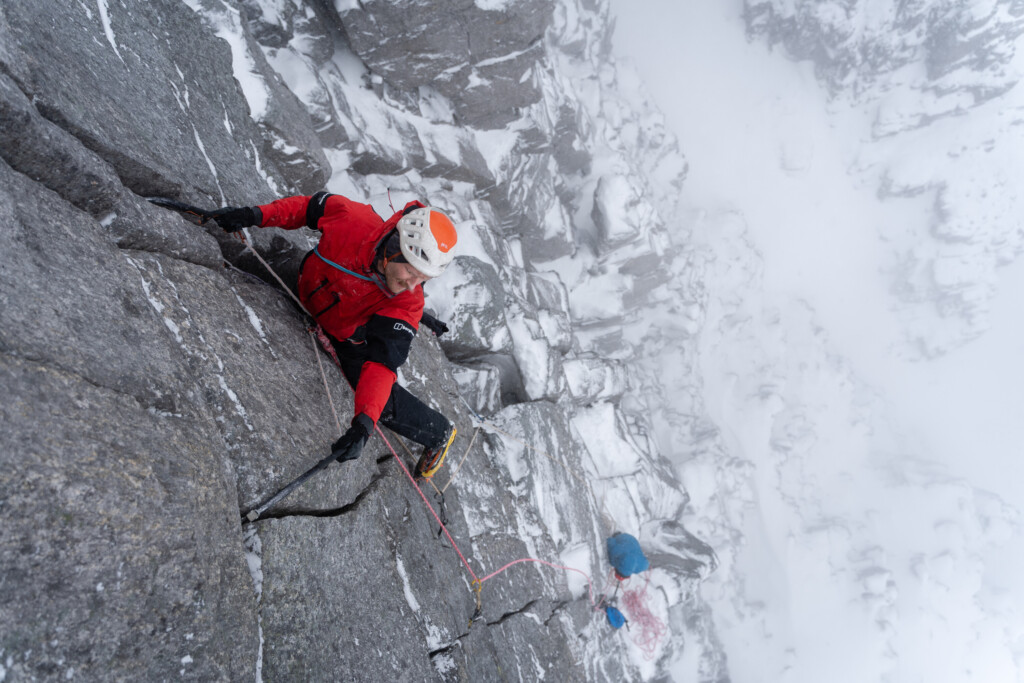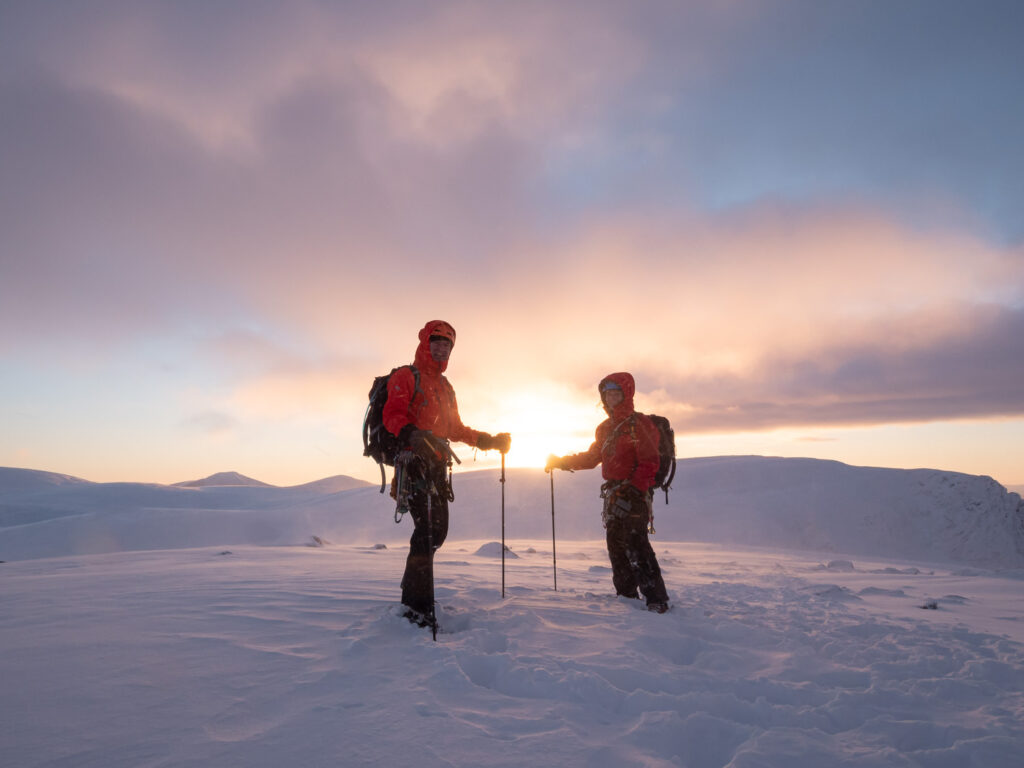
Castle Ridge with Mike De La Rue on the North Face of Ben Nevis, March 2022.
Scaling mountains grants access to some of the wildest and most remote regions on the planet; doing so in winter conditions is a sure fire way to increase not only the reward but also heighten the stakes. As arctic conditions creep across the Highlands, freezing burns and blanketing glens, in winter the Scottish wilderness can offer some of the most challenging environments in Europe.
For those seeking adventure, the possibilities are endless, but with absurdly short days, freezing temperatures and weather systems as volatile as they come, exploring these hostile landscapes is left only to those who have honed their skills and paid their dues. Having recently relocated north of the border, Alex Metcalfe spent the previous winter season doing exactly that.
Now, as the last of the snow thaws and thoughts shift to the soon to return midge population, Alex shares the eight things he’s learnt cutting his teeth during his first full winter season in Scotland, from the stunning and remote Northwest Highlands to the indomitable North Face of the Ben.

James Tamlyn set out to climb the SW Ridge IV 5 of the Douglas Boulder on Ben Nevis, Feb 2022.
#1. Location is King
Location, location, location. The adage couldn’t be more true.
In seasons past, my winter climbing trips were often arranged weeks in advance, or involved weekend blitzkrieg visits driving through the night to climb before returning to work the next day. Each time I’d never be quite sure of what conditions to expect.
With the increased flexibility of remote working it’s now more than possible to find a base close to the winter action. Having moved to the Highlands this winter, less than an hour from a major climbing venue, I’m now able to take advantage of fleeting cold snaps and climb routes rarely in condition for the weekend warrior.
This accessibility has also allowed me to spend more time on the hill and climb consistently which has lead to noticeable improvements in my skillset and knowledge base.

Carn Ban Mor, Cairngorms, Mar 2017.
#2. Head Out On Expedition
There are some great winter climbing venues in Scotland, but during good weather these can become congested. If you’re looking to escape the crowds, why not consider an expedition?
It doesn’t take long to hike in Scotland until it feels remote. Heading to a less frequented location like the Northwest Highlands with everything you need on your back can add a real sense of adventure to your trip.
Scotland is perfectly set-up for this and you can either camp or stay in one of the many bothies scattered across the country.

After climbing the NE Ridge of Angel’s Peak in Cairngorms National Park with Malcolm Harris, we hiked in through Creag a Chalamain and through the Lairig Ghru to stay at the Garbh Choire refuge. We then circled back around to Braeriach for a gorgeous sunset and nice gentle descent to this little bothy.
#3. Roll With the Punches
Getting the most out of Scottish winter climbing is about going where conditions are best. Too often it’s easy to set your heart on a route and climb in conditions unsuitable for the style required.
There are five styles of winter routes in Scotland; snowed up rock, mixed, icefalls, gullies and thin faces. These styles then require the right pattern of weather and snow build up for the greatest chance of success and enjoyment.
Make a list of your desired routes and educate yourself on the time of season it’s likely to be in, the weather conditions needed and what climbing style is required. Monitor the weather daily and when you’re free to climb choose a route that suits the conditions of the day.
Being flexible and going where conditions are best will also allow you to explore new areas and keep your climbing fresh.

The hike in and out can be as magical as the climb itself. Cairngorms National Park, Feb 2019.
#4. Learn to Ski
On days when there is sufficient snow coverage, skiing can be the quickest and easiest way to access a venue. After a hard day’s climb nothing beats quickly skiing across ground that could take twice that by foot.
Thanks to the Scotland’s cold weather and high, snow-covered peaks, there’s no shortage of ski resorts in which to learn and test your skills. Notable venues include the Glenshee Ski Centre, Glencoe Mountain Resort and Nevis Range Mountain Resort.
Outside of the resorts, Scotland has some fantastic backcountry skiing. The high massif of the Cairngorms is an ideal place for ski touring. The region claims five of the six highest mountains in the UK and is the most reliable venue for snow in the country.
From a pleasant tour up Ben Macdui, to skiing down Ben Nevis’ Number Five Gully there’s something for everyone.

Skiing for the first time in Scotland with Ross Spours and Francis Tocher at the Glencoe Mountain Resort.
#5. Embrace Unpredictability
The weather in Scotland is mercurial at best. Due to the country’s geography, predicting the weather can be challenging and you’ll often be left impatiently waiting for the next cold snap. But this is what makes Scotland so special, her unpredictability.
Although you may see snow on the mountain tops from late autumn to late spring, Scotland doesn’t enjoy snow-days as often as you might think. On the higher elevations, snow falls maybe 100 days of the year, but other regions may only see snow on 15 or 20 days annually.
As Nan Shepard wrote in her book The Living Mountain, ‘Winter on the high plateau can be delectable as honey; it can also be a roaring scourge. To those who love the place, both are good, since both are part of its essential nature.’

Climbing The Milky Way with Ailsa Macfie in Coire an Lochain.
#6. Be Patient
One time my partner and I walked into Coire an t-Sneachda in appalling visibility thanks to low cloud and snow. We arrived in the coire to meet disappointed teams walking out.
I was ready to call it a day, but my partner suggested going for a slow walk to see if conditions improved. As we toured the corie we caught glimpses of a blue sky overhead.
With conditions improving, we decided to solo the Fiacaill Buttress and as we climbed the cloud began to lift. By the time we topped out we had spectacular views over the Cairngorm plateau and the cloud had completely dispersed. What had initially looked like a failure turned into a great day.
This approach won’t always work, but what have you got to lose? Take your time, go for a walk and maybe, just maybe, conditions will improve.

A moment of calm in Cairngorms National Park.
#7. Develop a Deep Pool of Partners
I found over the winter season, a prudent approach to ensure the best chance of climbing was to develop a deep pool of partners.
There were invariably times when people would let me down due to family commitments, unforeseen circumstances, or just straight-up flakiness. I therefore built a solid list of potential and known climbing partners listing their abilities, experience, and where they were based.
This helped me to quickly find a partner when a weather window opened that matched my desired route and the conditions of the day.

Climbing with Danai Osmond in Stob Corrie an t-Sneachda in Cairngorm National Park to climb the grade III 4 route Grooved Rib.

Point Five Gully is perhaps the most famous gully in Scotland, and one of the world’s most sought-after winter climbs. Its first ascent, led by Ian Clough, in 1959 took 40 hours over 6 days and involved around 1000 feet of fixed rope and 60 rock and ice pitons. Point Five Gully with Diccon Proctor on the north face of Ben Nevis, March 2022.
#8. Be Prepared
Several times this season, the weather conditions have been different to those forecast and I’ve been caught out on the hill. Sometimes the wind chill was lower than expected or there was precipitation where non had been due.
Backpacks in Scottish winter climbing are already heavy enough and when conditions look good it’s often tempting to discard any gear not relevant to the forecast. Even with a promising forecast, I now plan for the worst and carry more than I think I’ll need. A blizzard bag, extra gloves, goggles and backup compass and map all have a permanent home in my bag.
Know the forecast, but be prepared to adapt should conditions change.
In my experience, it also pays to know a good bar for your return. There will inevitably be times when you’re late off the hill. A route may take longer than expected, you face adverse weather or you or your partner just isn’t having a good day.
Preparing a small bag with a change of clothes, drink and goodies can be a real morale booster after a tiring day. Even better is knowing the best local hospitality spots to call in on for a pint and warm food.
Wetherspoons in Fort William is often open late and serving food until 11pm. The Pine Martin in Glenmore stops serving food at 19:45, but is open until late allowing for a quick pint and debrief on the day’s adventures.

Climbing The Milky Way with Ailsa Macfie in Coire an Lochain, although turf was good, the powder made it hard to kick steps on this day.
Already mourning the possibility of waking up to a perfect blue bird powder day or happy to see the back of such short days? Either way you’ll now have to wait out the summer before hitting the Scottish Highlands for your own taste of winter climbing.
For more Scottish winter action from the past season, check out Hot Aches and Cold Snaps, or for more summer adventure, check out the best mountain biking routes in Scotland according to Scotty Laughland or Mark Bullock’s account of a big day on the Cuillin Ridge, Isle of Skye.
Don’t miss a single adventure
Sign up to our free newsletter and get a weekly BASE hit to your inbox
Other posts by this author

Story • Alex Metcalfe • Jan 03, 2023
How To Prepare For Your First Expedition
10 essential tips and things to 'know before you go'
You might also like

Photo Essay • BASE editorial team • Mar 18, 2024
Hunting happiness through adventure in Taiwan
BASE teams up with adventurer Sofia Jin to explore the best of Taiwan's underrated adventure scene.

Story • BASE editorial team • Nov 21, 2023
Five Epic UK Climbs You Should Try This Winter
Craving a snowy mountain adventure? Inspired by the Garmin Instinct 2 watch (into which you can directly plan these routes), we've compiled a list of five of the best for winter 2023-24!


Video • BASE editorial team • Jul 21, 2023
Merging Two Lives: The Personal Journey of Hamish Frost
The challenges and triumphs of embracing sexuality in the outdoors







